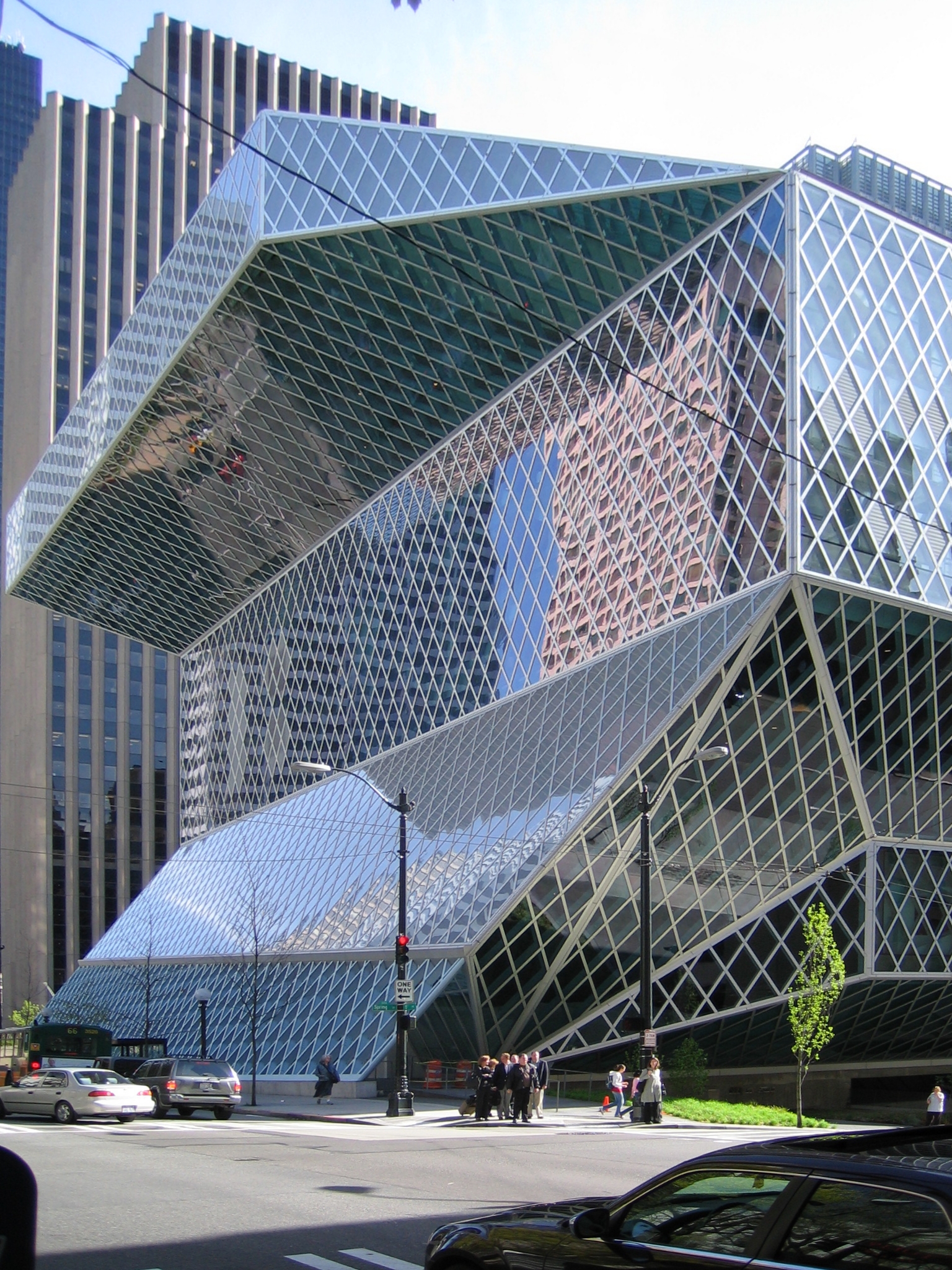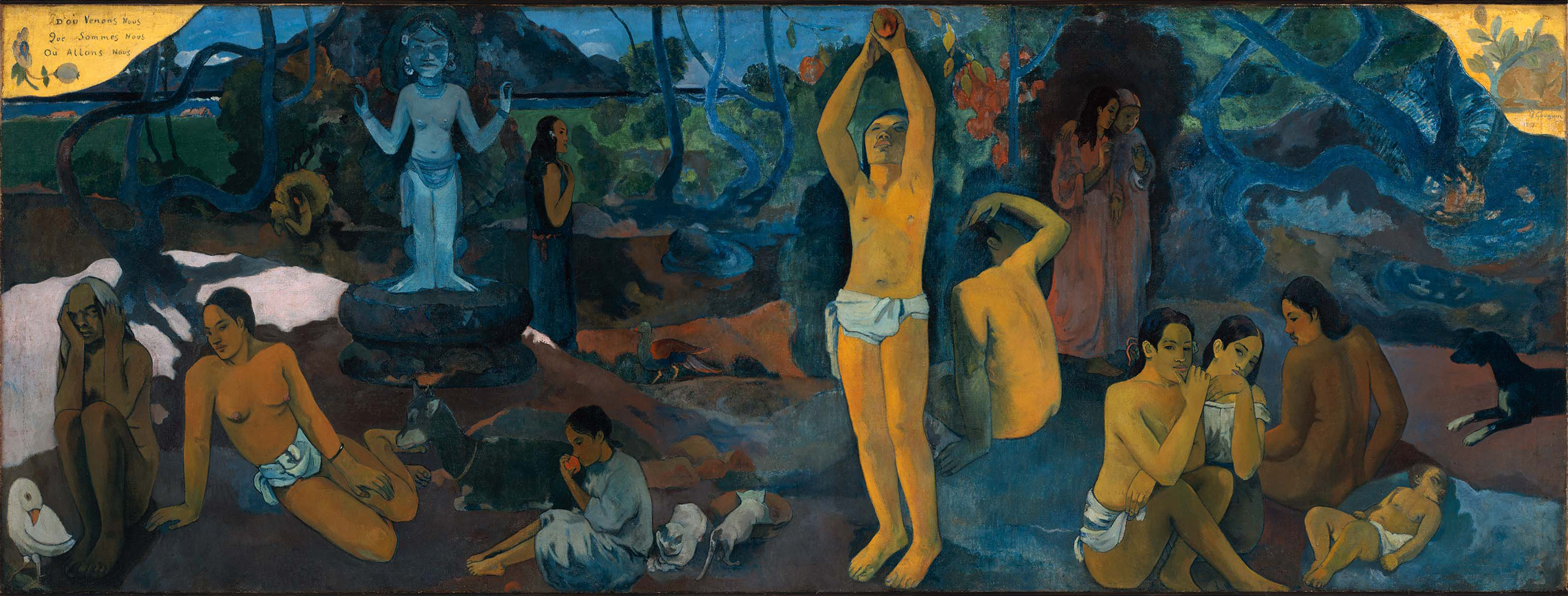|
Musée Des Confluences
The Musée des Confluences is a science centre and anthropology museum which opened on 20 December 2014 in the 2nd arrondissement of Lyon, (Rhône), France. It is located at the southern tip of the Presqu'île at the confluence of the Rhône and the Saône, adjacent to Autoroute A7, and comprises part of a larger redevelopment project of the Confluence quarter of Lyon. The deconstructivist architectural design, said to resemble a floating crystal cloud of stainless steel and glass, was created by the Austrian firm Coop Himmelb(l)au. History The museum includes collections of natural science, anthropology, and Earth Sciences of the Musée d'histoire naturelle - Guimet. These collections will be supplemented by exhibitions of arts and crafts. The four major exhibitions are called "Origins - Stories of the World", "Species - the Web of life", "Societies - Human theatre," and "Eternities - Visions of the beyond". The first exhibition deals with questions of origin, both the Big ... [...More Info...] [...Related Items...] OR: [Wikipedia] [Google] [Baidu] |
Handicraft
A handicraft, sometimes more precisely expressed as artisanal handicraft or handmade, is any of a wide variety of types of work where useful and decorative objects are made completely by one’s hand or by using only simple, non-automated related tools like scissors, carving implements, or hooks. It is a traditional main sector of craft making and applies to a wide range of creative and design activities that are related to making things with one's hands and skill, including work with textiles, moldable and rigid materials, paper, plant fibers,clay etc. One of the oldest handicraft is Dhokra; this is a sort of metal casting that has been used in India for over 4,000 years and is still used. In Iranian Baluchistan, women still make red ware hand-made pottery with dotted ornaments, much similar to the 5000-year-old pottery tradition of Kalpurgan, an archaeological site near the village. Usually, the term is applied to traditional techniques of creating items (whether for perso ... [...More Info...] [...Related Items...] OR: [Wikipedia] [Google] [Baidu] |
Coop Himmelblau
Coop Himmelb(l)au (A pun meaning ''Coop Sky Building'' and ''Coop Sky Blue'') is an architecture, urban planning, design, and art firm founded by Wolf D. Prix, Helmut Swiczinsky, and Michael Holzer in Vienna, Austria in 1968. History Coop Himmelb(l)au was founded in 1968 by Wolf D. Prix, Helmut Swiczinsky and Michael Holzer in Vienna and has been active in the fields of architecture, urban planning, design and art ever since. In 1988 a second studio was opened in Los Angeles. Further project offices are located in Frankfurt, Germany and Paris, France. The architecture studio Coop Himmelb(l)au is now run by Wolf D. Prix, Harald Krieger, Karolin Schmidbaur and project partners. The project partners include Michael Beckert, Luzie Giencke, Andrea Graser, Helmut Holleis, Markus Pillhofer, Markus Prossnigg, Wolfgang Reicht, Frank Stepper and Michael Volk. Michael Holzer early left the office in 1971. Helmut Swiczinsky retiredt from operational business in 2001, and his final retire ... [...More Info...] [...Related Items...] OR: [Wikipedia] [Google] [Baidu] |
Deconstructivism
Deconstructivism is a movement of postmodern architecture which appeared in the 1980s. It gives the impression of the fragmentation of the constructed building, commonly characterised by an absence of obvious harmony, continuity, or symmetry. Its name is a portmanteau of Constructivism and " Deconstruction", a form of semiotic analysis developed by the French philosopher Jacques Derrida. Architects whose work is often described as deconstructivist (though in many cases the architects themselves reject the label) include Zaha Hadid, Peter Eisenman, Frank Gehry, Rem Koolhaas, Daniel Libeskind, Bernard Tschumi, and Coop Himmelb(l)au. The term does not inherently refer to the style's ''deconstructed'' visuals as the English adjective suggests, but instead derives from the movement's foundations in contrast to the Russian Constructivist movement during the First World War that "broke the rules" of classical architecture through the French language. Besides fragmentation, d ... [...More Info...] [...Related Items...] OR: [Wikipedia] [Google] [Baidu] |
Museums In Lyon
A museum ( ; plural museums or, rarely, musea) is a building or institution that cares for and displays a collection of artifacts and other objects of artistic, cultural, historical, or scientific importance. Many public museums make these items available for public viewing through exhibits that may be permanent or temporary. The largest museums are located in major cities throughout the world, while thousands of local museums exist in smaller cities, towns, and rural areas. Museums have varying aims, ranging from the conservation and documentation of their collection, serving researchers and specialists, to catering to the general public. The goal of serving researchers is not only scientific, but intended to serve the general public. There are many types of museums, including art museums, natural history museums, science museums, war museums, and children's museums. According to the International Council of Museums (ICOM), there are more than 55,000 museums in 202 cou ... [...More Info...] [...Related Items...] OR: [Wikipedia] [Google] [Baidu] |
Culture In Lyon
Culture () is an umbrella term which encompasses the social behavior, institutions, and norms found in human societies, as well as the knowledge, beliefs, arts, laws, customs, capabilities, and habits of the individuals in these groups.Tylor, Edward. (1871). Primitive Culture. Vol 1. New York: J.P. Putnam's Son Culture is often originated from or attributed to a specific region or location. Humans acquire culture through the learning processes of enculturation and socialization, which is shown by the diversity of cultures across societies. A cultural norm codifies acceptable conduct in society; it serves as a guideline for behavior, dress, language, and demeanor in a situation, which serves as a template for expectations in a social group. Accepting only a monoculture in a social group can bear risks, just as a single species can wither in the face of environmental change, for lack of functional responses to the change. Thus in military culture, valor is counted a typica ... [...More Info...] [...Related Items...] OR: [Wikipedia] [Google] [Baidu] |
List Of Museums In France
A ''list'' is any set of items in a row. List or lists may also refer to: People * List (surname) Organizations * List College, an undergraduate division of the Jewish Theological Seminary of America * SC Germania List, German rugby union club Other uses * Angle of list, the leaning to either port or starboard of a ship * List (information), an ordered collection of pieces of information ** List (abstract data type), a method to organize data in computer science * List on Sylt, previously called List, the northernmost village in Germany, on the island of Sylt * ''List'', an alternative term for ''roll'' in flight dynamics * To ''list'' a building, etc., in the UK it means to designate it a listed building that may not be altered without permission * Lists (jousting), the barriers used to designate the tournament area where medieval knights jousted * '' The Book of Lists'', an American series of books with unusual lists See also * The List (other) * ... [...More Info...] [...Related Items...] OR: [Wikipedia] [Google] [Baidu] |
Death
Death is the irreversible cessation of all biological functions that sustain an organism. For organisms with a brain, death can also be defined as the irreversible cessation of functioning of the whole brain, including brainstem, and brain death is sometimes used as a legal definition of death. The remains of a former organism normally begin to decompose shortly after death. Death is an inevitable process that eventually occurs in almost all organisms. Death is generally applied to whole organisms; the similar process seen in individual components of an organism, such as cells or tissues, is necrosis. Something that is not considered an organism, such as a virus, can be physically destroyed but is not said to die. As of the early 21st century, over 150,000 humans die each day, with ageing being by far the most common cause of death. Many cultures and religions have the idea of an afterlife, and also may hold the idea of judgement of good and bad deeds in one's life ... [...More Info...] [...Related Items...] OR: [Wikipedia] [Google] [Baidu] |
Meaning Of Life
The meaning of life, or the answer to the question: "What is the meaning of life?", pertains to the significance of living or existence in general. Many other related questions include: "Why are we here?", "What is life all about?", or "What is the purpose of existence?" There have been many proposed answers to these questions from many different cultural and ideological backgrounds. The search for life's meaning has produced much philosophical, scientific, theological, and metaphysical speculation throughout history. Different people and cultures believe different things for the answer to this question. The meaning of life can be derived from philosophical and religious contemplation of, and scientific inquiries about existence, social ties, consciousness, and happiness. Many other issues are also involved, such as symbolic meaning, ontology, value, purpose, ethics, good and evil, free will, the existence of one or multiple gods, conceptions of God, the soul, and ... [...More Info...] [...Related Items...] OR: [Wikipedia] [Google] [Baidu] |
Society
A society is a group of individuals involved in persistent social interaction, or a large social group sharing the same spatial or social territory, typically subject to the same political authority and dominant cultural expectations. Societies are characterized by patterns of relationships ( social relations) between individuals who share a distinctive culture and institutions; a given society may be described as the sum total of such relationships among its constituent of members. In the social sciences, a larger society often exhibits stratification or dominance patterns in subgroups. Societies construct patterns of behavior by deeming certain actions or concepts as acceptable or unacceptable. These patterns of behavior within a given society are known as societal norms. Societies, and their norms, undergo gradual and perpetual changes. Insofar as it is collaborative, a society can enable its members to benefit in ways that would otherwise be difficult on an indivi ... [...More Info...] [...Related Items...] OR: [Wikipedia] [Google] [Baidu] |
Evolution (biology)
Evolution is change in the heritable characteristics of biological populations over successive generations. These characteristics are the expressions of genes, which are passed on from parent to offspring during reproduction. Variation tends to exist within any given population as a result of genetic mutation and recombination. Evolution occurs when evolutionary processes such as natural selection (including sexual selection) and genetic drift act on this variation, resulting in certain characteristics becoming more common or more rare within a population. The evolutionary pressures that determine whether a characteristic is common or rare within a population constantly change, resulting in a change in heritable characteristics arising over successive generations. It is this process of evolution that has given rise to biodiversity at every level of biological organisation, including the levels of species, individual organisms, and molecular evolution, molecules. The sci ... [...More Info...] [...Related Items...] OR: [Wikipedia] [Google] [Baidu] |







